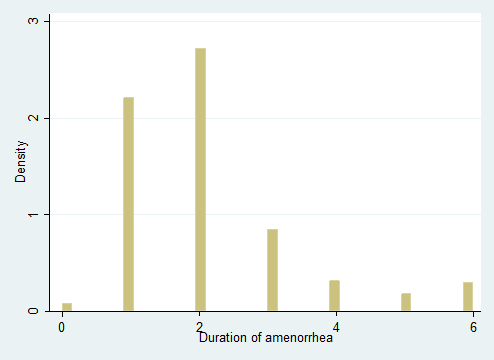Pengaruh Pemberian ASI Eksklusif terhadap Amenorrhea Laktasi di Indonesia
Influence of Exclusive breastfeeding behaviour with Lactation Amenorrhe in Indonesia
Keywords:
exclusive breastfeeding, lactation amenorrhea , women ever mateAbstract
Introduction: The long return of menstruation in postpartum mothers is strongly influenced by the exclusive breastfeeding behavior. In Indonesia is still relatively low compared to other countries, where the median return of menstruation in postpartum mothers in Indonesia is 2 months. The purpose of this study was to look at the influence of exclusive breastfeeding on lactation amenorrhea. Methode: This research is a quantitative research with cross sectional research design with research samples are women who have married aged 15-49 years, amounting to 10,143 people. This study uses SDKI data in 2017 with survival analysis. The results of this study do show the influence of exclusive breastfeeding on lactation amenorrhea after being controlled by confoding variables in the form of education, age, parity, residence and the use of birth control (p value 0,048 with an HR value of 2,32 (95% CI=1,98 – 2,49). The recommendation of this study is the need to increase KIA method related to the intensity and frequency of breastfeeding from mother to baby.
Downloads
References
DAFTAR PUSTAKA
Basuki, D. R., & Bahar, Y. (2018). Dengan Keteraturan Siklus Menstruasi Bagi Ibu-Ibu Menyusui Di Puskesmas Purwokerto. Sainteks, XIII(1), 42–49. http://jurnalnasional.ump.ac.id/index.php/SAINTEKS/article/download/1495/1333
BKKBN, BPS, Kemenkes, & USAID. (2018). Survei Demografi dan Kesehatan Indonesia Tahun 2017. https://www.bps.go.id/statictable/2020/10/21/2111/laporan-survei-demografi-dan-kesehatan-indonesia.html
Blake, D. K. &. (1956). The Social Structure of Fertility An Analitical Framework “Economic Development and Cultural Change. 1956. https://u.demog.berkeley.edu/~jrw/Biblio/Eprints/%20D-F/davis.blake.1956_intermediate.variables.pdf
Bongaarts, J. (1987). A Framework for Analyzing the Proximate Determinants of Fertility. Population Council, 4(1), 105–132. http://www.jstor.org/stable/1972149.
BPS, BKKBN, Kemenkes, & International, M. (2013). Survei Demografi dan Kesehatan Indonesia 2012. Kemenkes. https://doi.org/10.1111/j.1471-0528.2007.01580.x
International Institute for Population Sciences, & ICF. (2017). National Family Health Survey (Nfhs-4) 2015-16. https://dhsprogram.com/pubs/pdf/FR339/FR339.pdf
Karjatin, A. (2016). Modul Bahan Cetak: Keperawatan Maternitas (Vol. 3). Kemenkertian Kesehatan. http://repositorio.unan.edu.ni/2986/1/5624.pdf
Kemkes. (2019). Riset Kesehatan Dasar (Riskesdas) 2018. Kementerian Kesehatan. https://kesmas.kemkes.go.id/assets/upload/dir_519d41d8cd98f00/files/Hasil-riskesdas-2018_1274.pdf
Lausi, R. N., Susanti, A. I., Sari, P., & Astuti, S. (2017). Gambaran Metode Amenorea Laktasi Dan Cara Pemberian Asi Eksklusif Di Desa Cipacing Kecamatan Jatinangor. Jurnal Sistem Kesehatan, 3(1), 32–37. https://doi.org/10.24198/jsk.v3i1.13959
Lusa Rochmawati. (2017). Metode Amenorea Laktasi (MAL) atau Lactational Amenorrhea Method (LAM). https://lusa.afkar.id/metode-amenorea-laktasi-mal-atau-lactational-amenorrhea-method-lam
Mtawali, G., Angle, M., & Murphy, C. (1997). The Menstrual CycleIts Relation to Contraceptive Methods (A Reference for Reproductive Health Trainers). INTRAH. http://www.prime2.org/prime2/pdf/MenCyc.pdf
Pratidiana, I. M. (2016). Perbedaan Antara Lamanya Pemberian ASI Eksklusif dengan Inisiasai Menstruasi Post Partum di Puskesmas Kartasura [Muhammadiyah Surakarta]. In Fakultas Kedokteran UMS. http://eprints.ums.ac.id/43165/33/PUBLIKASI ILMIAH baru.pdf
Sharma, B., Ranjan, M., & Shekhar, C. (2016). Determinants and Differentials of Postpartum Amenorrhea Associated with ABreastfeeding among Women in Bihar , India. International Journal of Reproduction, Contraception, Obstetrics and Gynecology, 5(January), 154–165. https://doi.org/10.18203/2320-1770.ijrcog20151617
Singh, G. (2017). Estimation of The Duration of Postpartum Amenorrhea in The Presence of Some Cnsored Data. Obstet Gynecol India, 57(1), 53–57. https://jogi.co.in/storage/files/estimation-of-the-duration-of-postpartum-amenorrhea-in-the-presence-of-some-censored-data.pdf
Siregar, K. G. (2018). Perbandingan Waktu Datangnya Menstruasi Postpartum pada Ibu ASI Eksklusif dan Non ASI Eksklusif di Wilayah Kerja Puskesmas Padang Bulan [Fakultas Keperawatan Universitas Sumatera Utara]. https://repositori.usu.ac.id/handle/123456789/9855?show=full
Suparmi. (2010). Pengaruh ASI Ekslusif Terhadap Amenorrhea Laktasi di Indonesia (Analisis Data SDKI 2007) [FKM UI]. https://www.researchgate.net/publication/288888949%0ADeterminants
The Jhons Hopkins Univerity, WHO, & USAID. (2018). Family Planning A Global Handbook for Providers. In Family Planning (Fourth, pp. 309–318). WHO. https://www.who.int/publications-detail-redirect/9780999203705
Tran, N. T., Seuc, A., Coulibaly, A., Landoulsi, S., Millogo, T., Sissoko, F., Yameogo, W. M. E., & Zan, S. (2018). Articles Post-Partum Family Planning in Burkina Faso ( Yam Daabo ): A Two Group, Multi-Intervention, Single-Blinded, Cluster-Randomised Controlled Trial. The Lancet Global Health, 7(8), e1109–e1117. https://doi.org/10.1016/S2214-109X(19)30202-5
UN. (2016). Trends in Contraceptive Use Worldwide 2015. United Nation. https://www.un.org/development/desa/pd/sites/www.un.org.development.desa.pd/files/undesa_pd_report_2015_trends_contraceptive_use.pdf
UN. (2019). Data Booklet: Contraceptive Use by Method 2019. United Nation. https://www.un.org/development/desa/pd/sites/www.un.org.development.desa.pd/files/files/documents/2020/Jan/un_2019_contraceptiveusebymethod_databooklet.pdf
USAID, & Georgetown Univercity. (2015). Lactational Amenorrhea Method (A Reference Manual for Service Providers). Georgetown University, Institute for Reproductive Health. https://irh.org/wp-content/uploads/2013/04/LAM_ReferenceManual.pdf

Published
How to Cite
Issue
Section
Copyright (c) 2022 Mona Safitri Fatiah, Yane Tambing, Robani Catursaptani

This work is licensed under a Creative Commons Attribution-ShareAlike 4.0 International License.
Authors who publish with Jurnal Bidan Cerdas agree to the following terms:
- Authors retain copyright and grant the journal right of first publication with the work simultaneously licensed under a Creative Commons Attribution License (CC BY-SA 4.0) that allows others to share the work with an acknowledgment of the work's authorship and initial publication in this journal.
- Authors are able to enter into separate, additional contractual arrangements for the non-exclusive distribution of the journal's published version of the work (e.g., post it to an institutional repository or publish it in a book), with an acknowledgment of its initial publication in this journal.
- Authors are permitted and encouraged to post their work online (e.g., in institutional repositories or on their website) prior to and during the submission process, as it can lead to productive exchanges, as well as earlier and greater citation of published work.

This work is licensed under a Creative Commons Attribution-Share Alike 4.0 International License
You are free to:
- Share, copy and redistribute the material in any medium or format
- Adapt, remix, transform, and build upon the material for any purpose, even commercially.
- The licensor cannot revoke these freedoms as long as you follow the license terms.




